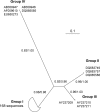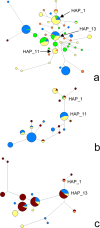Phylogenetic approach to the variability of the microsporidian Enterocytozoon bieneusi and its implications for inter- and intrahost transmission
- PMID: 20228101
- PMCID: PMC2869117
- DOI: 10.1128/AEM.03026-09
Phylogenetic approach to the variability of the microsporidian Enterocytozoon bieneusi and its implications for inter- and intrahost transmission
Abstract
Enterocytozoon bieneusi is a microsporidian parasite that infects many vertebrate animals, including humans. The rDNA internal transcribed spacer (ITS) shows a hypervariable sequence; however, so far no clear information has been inferred about strain evolution in this species. We reviewed all the sequences described and performed a phylogenetic study. Four groups of sequences strongly differentiated from each other were detected, although most of the isolates (94%) corresponded to group I. The highly diverse sequences of this group were analyzed using median-joining networks. The host species (humans, pets, swine, cattle, birds, and wild animals) and the continents of origin of the isolates were considered. Central haplotypes in the network were obtained from very diverse hosts and geographical origins. The results show that although E. bieneusi has a broad host specificity, transmission is not completely free: some strains were able to circulate within a given host species and were only occasionally transmitted to another host. Additionally, while not relevant for swine or cattle hosts, geography seems to be a relevant factor for human infection by E. bieneusi.
Figures



Similar articles
-
Genetic diversity within dominant Enterocytozoon bieneusi genotypes in pre-weaned calves.Parasit Vectors. 2018 Mar 12;11(1):170. doi: 10.1186/s13071-018-2768-x. Parasit Vectors. 2018. PMID: 29530084 Free PMC article.
-
Enterocytozoon bieneusi in Dairy Cattle in the Northeast of China: Genetic Diversity of ITS Gene and Evaluation of Zoonotic Transmission Potential.J Eukaryot Microbiol. 2015 Jul-Aug;62(4):553-60. doi: 10.1111/jeu.12210. Epub 2015 Mar 16. J Eukaryot Microbiol. 2015. PMID: 25712195
-
Occurrence, molecular characterization and predominant genotypes of Enterocytozoon bieneusi in dairy cattle in Henan and Ningxia, China.Parasit Vectors. 2016 Mar 11;9:142. doi: 10.1186/s13071-016-1425-5. Parasit Vectors. 2016. PMID: 26968376 Free PMC article.
-
Potential impacts of host specificity on zoonotic or interspecies transmission of Enterocytozoon bieneusi.Infect Genet Evol. 2019 Nov;75:104033. doi: 10.1016/j.meegid.2019.104033. Epub 2019 Sep 5. Infect Genet Evol. 2019. PMID: 31494271 Review.
-
Enterocytozoon bieneusi in human and animals, focus on laboratory identification and molecular epidemiology.Parasite. 2008 Sep;15(3):349-58. doi: 10.1051/parasite/2008153349. Parasite. 2008. PMID: 18814706 Review.
Cited by
-
Cryptosporidium spp. and Enterocytozoon bieneusi in introduced raccoons (Procyon lotor)-first evidence from Poland and Germany.Parasitol Res. 2016 Dec;115(12):4535-4541. doi: 10.1007/s00436-016-5245-5. Epub 2016 Sep 14. Parasitol Res. 2016. PMID: 27630099 Free PMC article.
-
Molecular characterization of human-pathogenic microsporidia and Cyclospora cayetanensis isolated from various water sources in Spain: a year-long longitudinal study.Appl Environ Microbiol. 2013 Jan;79(2):449-59. doi: 10.1128/AEM.02737-12. Epub 2012 Nov 2. Appl Environ Microbiol. 2013. PMID: 23124243 Free PMC article.
-
Occurrence of microsporidia spp. infection in children with diarrhea in southern Iran.J Parasit Dis. 2022 Dec;46(4):1127-1132. doi: 10.1007/s12639-022-01535-w. Epub 2022 Oct 3. J Parasit Dis. 2022. PMID: 36457786 Free PMC article.
-
Epidemiology of Enterocytozoon bieneusi Infection in Humans.J Parasitol Res. 2012;2012:981424. doi: 10.1155/2012/981424. Epub 2012 Oct 3. J Parasitol Res. 2012. PMID: 23091702 Free PMC article.
-
Molecular Detection of Zoonotic Microsporidia in Domestic Cats in Turkey: A Preliminary Study.Acta Parasitol. 2019 Mar;64(1):13-18. doi: 10.2478/s11686-018-00003-x. Epub 2019 Jan 15. Acta Parasitol. 2019. PMID: 30645737
References
-
- Abe, N., I. Kimata, and M. Iseki. 2009. Molecular evidence of Enterocytozoon bieneusi in Japan. J. Vet. Med. Sci. 71:217-219. - PubMed
-
- Adl, S. M., A. G. Simpson, M. A. Farmer, R. A. Andersen, O. R. Anderson, J. R. Barta, S. S. Bowser, G. Brugerolle, R. A. Fensome, S. Fredericq, T. Y. James, S. Karpov, P. Kugrens, J. Krug, C. E. Lane, L. A. Lewis, J. Lodge, D. H. Lynn, D. G. Mann, R. M. McCourt, L. Mendoza, O. Moestrup, S. E. Mozley-Standridge, T. A. Nerad, C. A. Shearer, A. V. Smirnov, F. W. Spiegel, and M. F. Taylor. 2005. The new higher level classification of eukaryotes with emphasis on the taxonomy of protists. J. Eukaryot. Microbiol. 52:399-451. - PubMed
-
- Bandelt, H. J., P. Forster, and A. Röhl. 1999. Median-joining networks for inferring intraspecific phylogenies. Mol. Biol. Evol. 16:37-48. - PubMed
-
- Bornay-Llinares, F. J., A. J. da Silva, H. Moura, D. A. Schwartz, G. S. Visvesvara, N. J. Pieniazek, A. Cruz-López, P. Hernández-Jauregui, J. Guerrero, and F. J. Enríquez. 1998. Immunologic, microscopic, and molecular evidence of Encephalitozoon intestinalis (Septata intestinalis) infection in mammals other than humans. J. Infect. Dis. 178:820-826. - PubMed
-
- Breitenmoser, A. C., A. Mathis, E. Bürgi, R. Weber, and P. Deplazes. 1999. High prevalence of Enterocytozoon bieneusi in swine with four genotypes that differ from those identified in humans. Parasitology 118:447-453. - PubMed
MeSH terms
Substances
LinkOut - more resources
Full Text Sources

